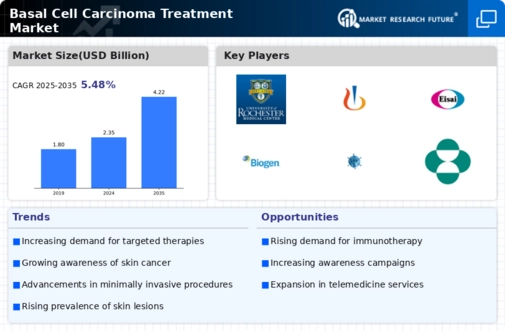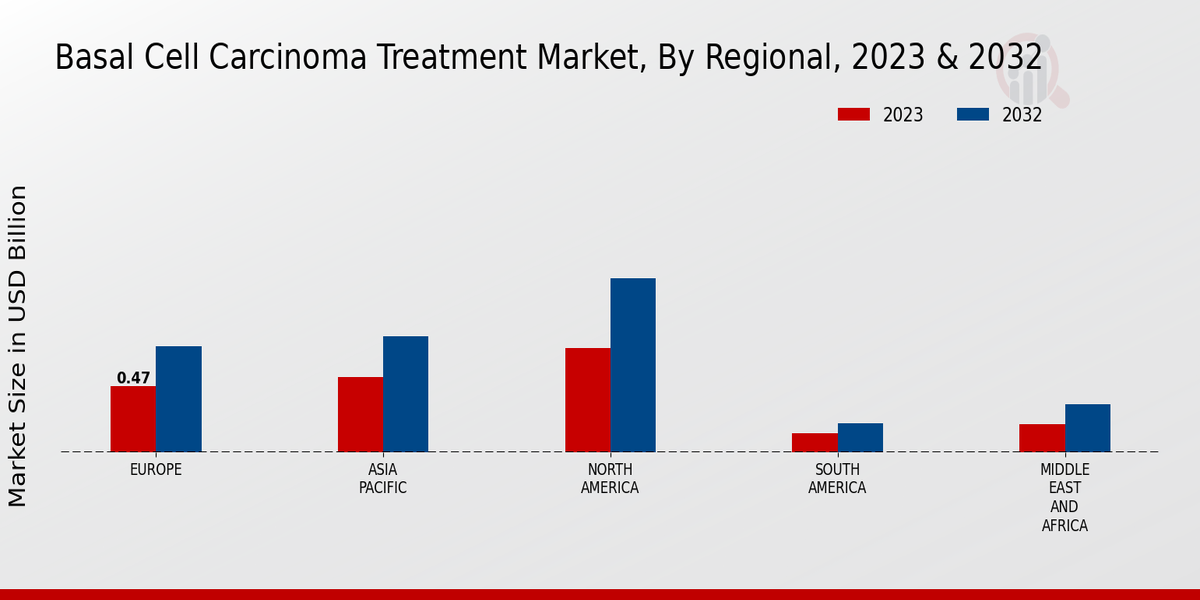Market Growth Projections
The Global Basal Cell Carcinoma Treatment Market Industry is projected to experience robust growth, with a compound annual growth rate (CAGR) of 5.46% anticipated from 2025 to 2035. This growth trajectory is indicative of the increasing demand for effective treatment options and the ongoing advancements in medical technology. As the market evolves, it is expected to reach a value of 4.22 USD Billion by 2035. This upward trend reflects the industry's response to the rising incidence of basal cell carcinoma and the need for innovative therapies that cater to diverse patient populations.
Growing Geriatric Population
The aging population is a significant factor influencing the Global Basal Cell Carcinoma Treatment Market Industry. As individuals age, their risk of developing skin cancers, including BCC, increases. According to the World Health Organization, the global population aged 60 years and older is expected to reach 2.1 billion by 2050. This demographic shift is likely to lead to a higher incidence of BCC, thereby increasing the demand for effective treatment options. The Global Basal Cell Carcinoma Treatment Market Industry is expected to grow as healthcare systems adapt to meet the needs of this vulnerable population, with a projected market value of 4.22 USD Billion by 2035.
Advancements in Treatment Technologies
Technological innovations in the treatment of basal cell carcinoma are transforming the Global Basal Cell Carcinoma Treatment Market Industry. Techniques such as Mohs micrographic surgery and photodynamic therapy are gaining traction due to their effectiveness and minimally invasive nature. These advancements not only improve patient outcomes but also enhance the overall treatment experience. The integration of new technologies is expected to contribute to the market's growth, with projections indicating a market value of 2.35 USD Billion in 2024. As healthcare providers adopt these innovative treatments, the Global Basal Cell Carcinoma Treatment Market Industry is likely to expand significantly.
Rising Awareness and Screening Programs
Increased awareness of skin cancer and the importance of early detection are pivotal drivers in the Global Basal Cell Carcinoma Treatment Market Industry. Public health campaigns and educational initiatives are encouraging individuals to undergo regular skin checks, leading to earlier diagnosis and treatment of BCC. For example, initiatives by dermatological associations promote skin cancer awareness, resulting in higher screening rates. This proactive approach not only aids in reducing mortality rates but also stimulates demand for treatment options. Consequently, the Global Basal Cell Carcinoma Treatment Market Industry is poised for growth as more patients seek timely interventions.
Increasing Incidence of Basal Cell Carcinoma
The Global Basal Cell Carcinoma Treatment Market Industry is witnessing a surge in demand due to the rising incidence of basal cell carcinoma (BCC). Factors such as increased sun exposure and aging populations contribute to this trend. For instance, the American Academy of Dermatology reports that BCC is the most common form of skin cancer, affecting millions globally. This growing prevalence necessitates effective treatment options, driving market growth. As awareness of skin cancer increases, more individuals seek medical intervention, further propelling the Global Basal Cell Carcinoma Treatment Market Industry.
Regulatory Support and Reimbursement Policies
Supportive regulatory frameworks and favorable reimbursement policies are crucial for the Global Basal Cell Carcinoma Treatment Market Industry. Governments and health organizations are increasingly recognizing the importance of accessible cancer treatments, leading to improved reimbursement rates for BCC therapies. This support encourages healthcare providers to offer a wider range of treatment options, enhancing patient access to necessary care. As reimbursement policies evolve to cover innovative therapies, the Global Basal Cell Carcinoma Treatment Market Industry is likely to experience growth, driven by increased patient enrollment in treatment programs.


















